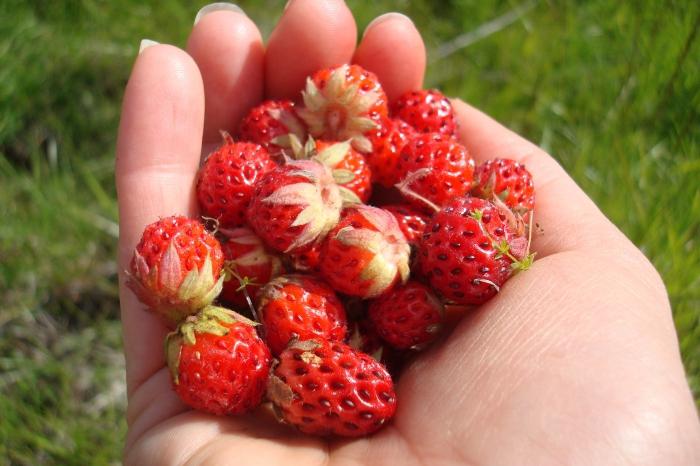Perhaps it’s worth immediately clarifying: wild strawberries have nothing to do with strawberries. They are not even relatives, according to some gardeners. There are striking differences in the form of leaves and berries, and in taste and aroma.
The ancestors of
strawberry garden came to us from North America, and wild strawberries "born" on our lands. The leaves of the plant are complex, triple, oval-rhombic in shape, dark green above and silky-pubescent below. The roots are oblique, less commonly horizontal. Overhead shoots of two types (vegetative, generative). The latter can grow up to 25 cm and end with a small corymbose inflorescence with a whorl of bracts.
Wild strawberries propagate mainly vegetatively. Most berries ripen by early July. By the way, the fruits are not berries, but tiny "nuts" immersed in the pulp with their base. Strawberry is actually an overgrown receptacle. When ripe, it is bright red, very fragrant and sweet.
It grows in meadows, clear clearings, edges of mostly deciduous forests. You can meet her on forest fires, clearings, at the side of the highway and on the slopes of the railways.
You may be interested in the fact that strawberries are divided into several types: each grows on its territory (the Far East, Western Siberia, China, the European part of Russia, Mongolia), but they are all so similar that a person who does not have a special botanical education , it is difficult to distinguish berries from areas of Transbaikalia from berries from the Moscow region.
Wild strawberries contain a lot of sugar, calcium, iron salts, acids, trace elements, macroelements, oils. As a food product, berries have been used since antiquity. It is very tasty and fragrant in jams, jams, compotes. With it you can cook puddings and pies.
With strawberry leaves, harvested in spring or late autumn, dried and properly fermented, it is quite possible to replace tea, which will be much nicer than the one we used to buy in stores. By the way, it is not only tasty, but also useful to those who often catch a cold. If you are not very familiar with the technology of preparing fermented tea, you can do with strawberry leaves cut in the flowering season (they are dried only in the shade, connected by small bunches, in limbo). Berries must be picked in the morning, as soon as the dew comes off, or already when the heat subsides. They are dried, like the leaves, also in the shade or in an oven heated to 40 ° C. The dried berry darkens, turning bright red.

The medicinal properties of strawberries were mentioned in ancient literature (Virgil, Ovid), and Mattsoli (botanist and doctor, XVI century) wrote that its berries are used not only as a treat and food, but also have choleretic effects, relieve thirst and heat help with stomach pain.
Alcohol tincture is an amazing tool against unwanted tanning, against clouding on the cornea. Roots and leaves of strawberries heal ulcers and wounds, reduce the spleen, strengthen the gums, loose teeth.
Field wild strawberry perfectly copes with a cold and even prevents it, expels stones from the liver and kidneys, and is used as a diuretic and anti-vitamin remedy. Infusion of leaves is able to dilate blood vessels, and therefore is effective for hypertension in the initial stage. Fresh berries (or dried and soaked) are indicated for gout, constipation, ulcers, atherosclerosis, hypertension. They not only improve digestion and stimulate appetite, but also increase hemoglobin. However, not all strawberries are useful. Undesirable reactions are sometimes possible - Quincke's edema, urticaria, itching.